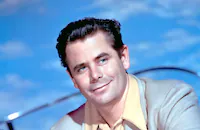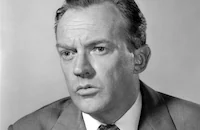Day of the Evil Gun

Brief Synopsis
Cast & Crew
Jerry Thorpe
Glenn Ford
Arthur Kennedy
Dean Jagger
John Anderson
Paul Fix
Film Details
Technical Specs

Synopsis
Three years after leaving home, gunfighter Lorn Warfield returns to find his ranch in ruin and to hear from a neighbor, Owen Forbes, that his wife, Angie, and two daughters have been taken by the Apaches. The minister's wife, Lydia Yearby, was also captured but was mysteriously returned. Lydia provides Lorn with little information about his family, but he learns more from Jimmy Noble, an old trader who feigns insanity as protection against the Indians. Accompanied by Forbes, who reveals that Angie has consented to marry him because she believes Lorn to be dead, Lorn sets out in search of his family. Lorn and Forbes are captured by Indians but are saved by DeLeón, a Mexican bandit. Continuing their search, they reach a town being held by a band of Confederate renegades led by Capt. Jefferson Addis. The town is attacked by Indians, who leave with two wagons loaded with munitions. Lorn and Forbes follow the wagon tracks to the Indian camp and rescue Angie and the two children. Once safely home, Angie chooses to remain with her husband, whereupon Forbes challenges Lorn to a duel; but Lorn, who has exchanged his gun for food and clothing for his family, refuses to fight. Nevertheless, Forbes wounds Lorn and is about to shoot again when he is himself shot by the storekeeper, using Lorn's traded gun.

Director
Jerry Thorpe
Cast

Glenn Ford

Arthur Kennedy

Dean Jagger
John Anderson

Paul Fix
Nico Minardos

Dean Stanton
Pilar Pellicer

Parley Baer

Royal Dano

Ross Elliott
Barbara Babcock

James Griffith
Crew
Jack Aldworth
Jeff Alexander
Alex Beaton
Eric Bercovici
Ernesto Carrasco
George W. Davis
Henry Grace
W. Wallace Kelley
Franklin Milton
Lloyd Richards
Marvin Summerfield
Jerry Thorpe
James T. Vaughn
Charles Marquis Warren
Charles Marquis Warren

Film Details
Technical Specs

Articles
Day of the Evil Gun
Top-billed Glenn Ford was past the most successful run of his career but still a solid screen presence who could be counted on to carry a picture, even a low-budget double-bill filler such as this. In pictures since the late 1930s, Ford had a long and successful screen career interrupted only briefly by World War II service. Easily adaptable to crime thrillers (Gilda, 1946; The Big Heat, 1953), romantic leads (A Stolen Life, 1946, hand-picked by the film's star, Bette Davis; The Loves of Carmen, 1948, with Rita Hayworth), and sparkling comedy (The Teahouse of the August Moon, 1956; Pocketful of Miracles, 1961, again with Davis), Ford always projected the air of a decent fellow, often caught up in adverse circumstances, such as the ghetto schoolteacher in Blackboard Jungle (1955), one of his most famous roles.
Ford also appeared in many Westerns: the offbeat The Fastest Gun Alive (1956), the tensely psychological 3:10 to Yuma (1957), and the comic The Sheepman (1958), all made during a period when the actor frequently made the list of top ten box office attractions. In a number of his Westerns, Ford often projected an air of neuroses and a more complicated persona that anticipated the protagonists of the revisionist Westerns of the 1960s, and his role in this picture fits that category. Day of the Evil Gun was the third in a five-film string of Westerns Ford made between 1967 and 1969 before moving to television as the star of the series Cade's County, set in the modern-day West. This film was originally made for showing on ABC-TV, but the studio opted to release it to theaters first.
Ford's co-star in the picture is Arthur Kennedy, a versatile actor who, despite never achieving star status, had a long and highly acclaimed career in film and theater. He had great success in the late 1940s in two Arthur Miller plays, All My Sons and Death of a Salesman, winning a Tony Award for the latter. Kennedy was nominated for a Best Actor Academy Award® for Bright Victory (1951), which also won him the New York Film Critics Circle Award that year. He was also nominated four times as Best Supporting Actor: Champion (1949), Trial (1955), Peyton Place (1957), and Some Came Running (1958).
The film was shot in Mexico by W. Wallace Kelley, the cinematographer of twelve Jerry Lewis pictures during this decade. He also did special effects work on Alfred Hitchcock's Vertigo (1958) and the sci-fi classic The War of the Worlds (1953). Day of the Evil Gun was produced and directed by Jerry Thorpe, whose father, Richard Thorpe, retired after making Glenn Ford's previous picture (also a Western), The Last Challenge (1967).
Producer/Director: Jerry Thorpe
Screenplay: Charles Marquis Warren, Eric Bercovici
Cinematography: W. Wallace Kelley
Editing: Alex Beaton
Art Direction: George W. Davis, Marvin Summerfield
Original Music: Jeff Alexander
Cast: Glenn Ford (Lorne Warfield), Arthur Kennedy (Owen Forbes), Dean Jagger (Jimmy Noble), Paul Fix (Sheriff Kelso), Harry Dean Stanton (First Sgt. Parker).
BW-91m. Letterboxed. Closed captioning.
by Rob Nixon

Day of the Evil Gun
Quotes
Trivia
Notes
Filmed on location in Durango, Mexico; working title: Evil Gun.















